Text
The Shadow/Batman, illustration by Jorge Fornés

The Shadow/Batman #6, cover by Jorge Fornés
59 notes
·
View notes
Text
The show was based on the exploits of clean-cut, square-jawed Rocky Jones, the best known of the Space Rangers. These were Earth-based space policemen who patrolled the United Worlds of the Solar System in the not-too-distant future. Rocky and his crew would routinely blast-off in a V-2-like, chemically-fueled, upright rocketship, the Orbit Jet XV-2. It was later replaced by the nearly identical Silver Moon XV-3 on missions to moons and planetoids, where the odds of success seemed remote, yet they would always prevail. Although they might destroy a rocketship full of unseen villains, their space pistols were never fired at people, and conflicts were always resolved with only fistfights.
Although many strange worlds were visited, the alien characters usually spoke American English, and always appeared as normal humans, albeit wearing bizarre costumes in normal environments. The script-writers did not appear to know the difference between planets, moons, stars, and constellations, so that the specific locations Rocky and his sidekicks visited are generally unknown to astronomers.
...
[wikipedia]
Rocky Jones on IMDb

93 notes
·
View notes
Text
British MRC Body Armour
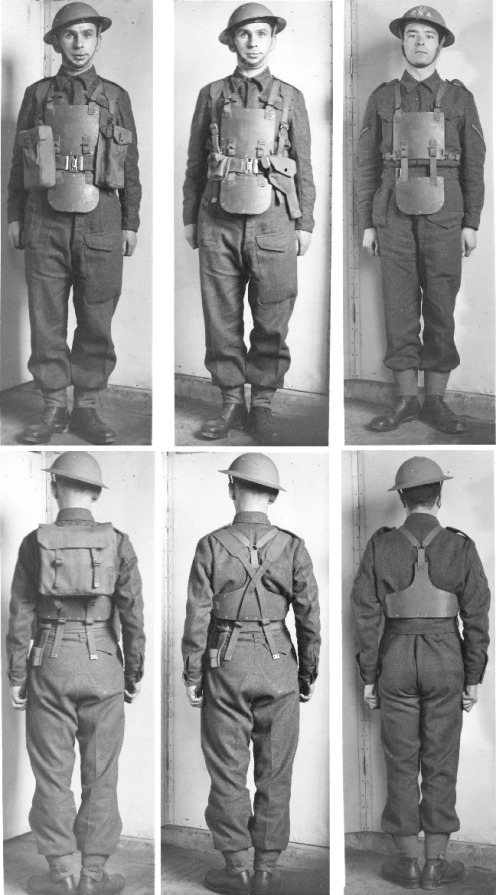
Developed by the British medical research Council between 1940 and 1942 to equip frontline troops, issued in April of 1942. 1mm manganese steel - equivalent to a Brodie helmet, 1,6kg, three parts, covered in canvas. Protects from .38/200 rounds at 5m, from .45ACP rounds from a Thompson submachinegun at 90m and from .303 British rounds at 640m.
Although the initial order for this armor was originally of 500000 units, only 200000 were made and 72000 issued due in part to sharing its material requirements with helmets, which were a much higher priority, and because it was found that
“Although well padded, [that they] tended to cut into the soft-skin areas of the body causing chafing, with the result that violent and rapid movements were significantly impaired. Moreover, it causes a man to perspire so profusely that his powers of endurance were affected.” - Simon Dunstan, Flak Jackets 20th Century Military Body Armour.
Their use although perhaps not as efficient as intended still gave soldiers a boost of confidence when part of the first line of assault, and the armor was used in majority by airborne forces of the RAF where it protected their vitals from spalling and low velocity shrapnel. This all took place in parallel with the private development of the Wilkinson M1 Flak jacket that was issued in 1943.
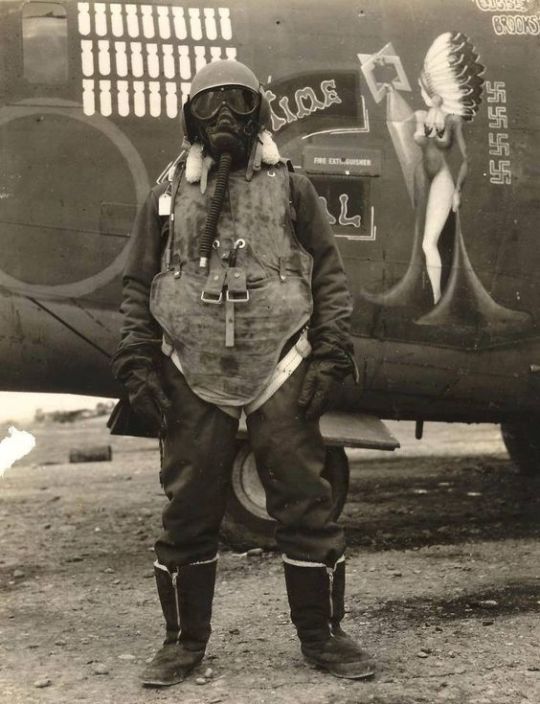
pictured thusly.
148 notes
·
View notes
Text


OSS T-13 “Beano” hand grenade
Sauce: liveauctioneers.com; Cowan Auctions
Designed by the Office of Strategic Service c.1944 for general issue to American recruits, briefly manufactured by the Eastman Kodak Corp. in time for D-Day. 255g of explosive out of a 340g total weight, percussive grenade design.
The T-13 was an experimental grenade design meant to mimic the weight, size and handling of a baseball, making it easy for new recruits to handle and throw them. Instead of a safety lever, the T-13 had a knurled weighted cap held in place by your usual pin. With the pin removed, the cap was held in place by the soldier throwing the grenade like a knuckle ball with two or three fingers pressed on it. When thrown, the cap was released and dragged a nylon string behind it that pulled on a pressure sensitive arming device, at which point any shock would instantly set of the explosive charge. Although its basic principle was sound, the T-13′s percussive design proved to be its downfall. Like with literally all other similar percussion-detonated designs, which were common in the early days of WW1, accidental/premature detonations were very common in the field, and it is believed this grenade killed more GI’s than enemy soldiers. After that brief episode of disastrous field testing, all accounted for T-13 grenades were recalled and destroyed and all the documents pertaining to its design and use were classified.
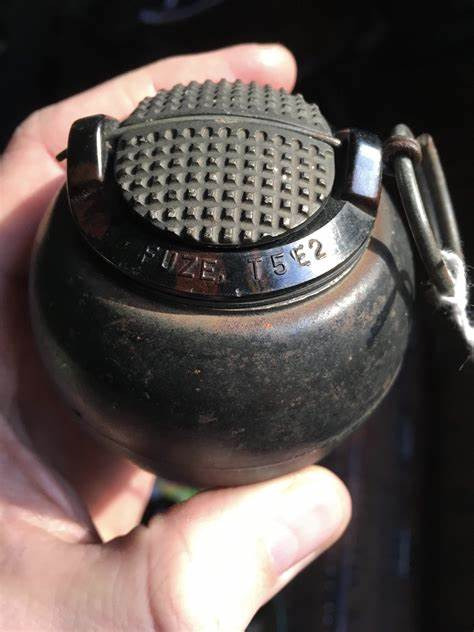
301 notes
·
View notes
Photo
Color Captain Satan cover illustration by Malvin Singer
June, 1938


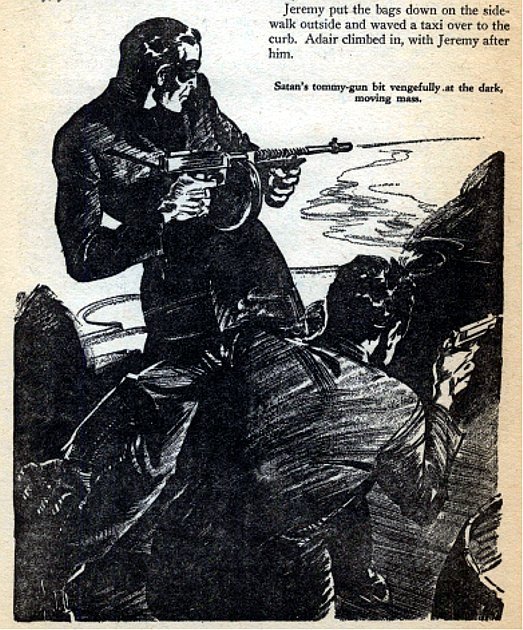
After just two issue Strange Detective Stories was changed to Captain Satan and became for five issues the home of one of the more odd pulp heroes.
I have no idea who the artist is.
173 notes
·
View notes
Photo
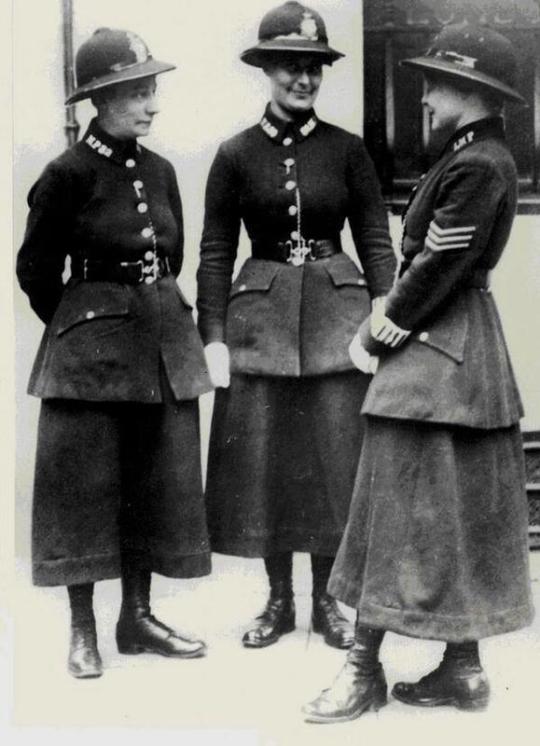
1919 The first Metropolitan Police Women Patrols took to the streets of London. The National Union of Women Workers were given a year-long contract to see if they could do the same job as a male police officer - although they weren’t given the power of arrest. In December, 1922, fifty female officers were sworn into the force with the same powers to arrest as men. From Mikki’s 1900-1919 History Resource, FB.
172 notes
·
View notes
Photo



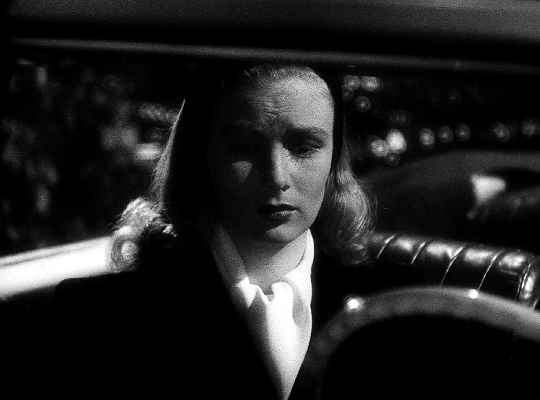




It all blows up in your face sometimes, doesn’t it?
Veronica Lake as Joyce Harwood in The Blue Dahlia (1946) dir. George Marshall
1K notes
·
View notes
Photo
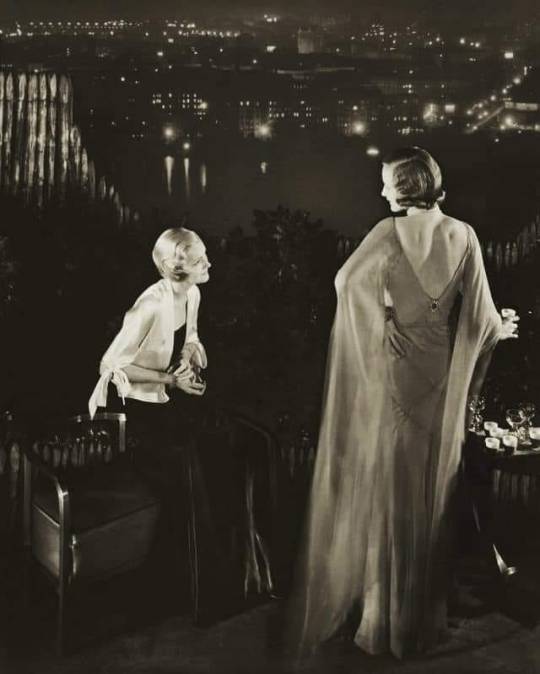
1930 Gowns by Lanvin and Chanel for “Vogue” by Edward Steichen. From Fashion of Bygone Days, FB.
512 notes
·
View notes
Photo



The Legend of Korra - The Art of the Animated Series - Book 03 - Change (2015)
771 notes
·
View notes
Photo
'G-8 and his Battle Aces'
Illustration by Frederick Blakeslee

The Hurricane Patrol
https://pulpcovers.com/the-hurricane-patrol/
48 notes
·
View notes
Photo
Modern Mechanix does airships
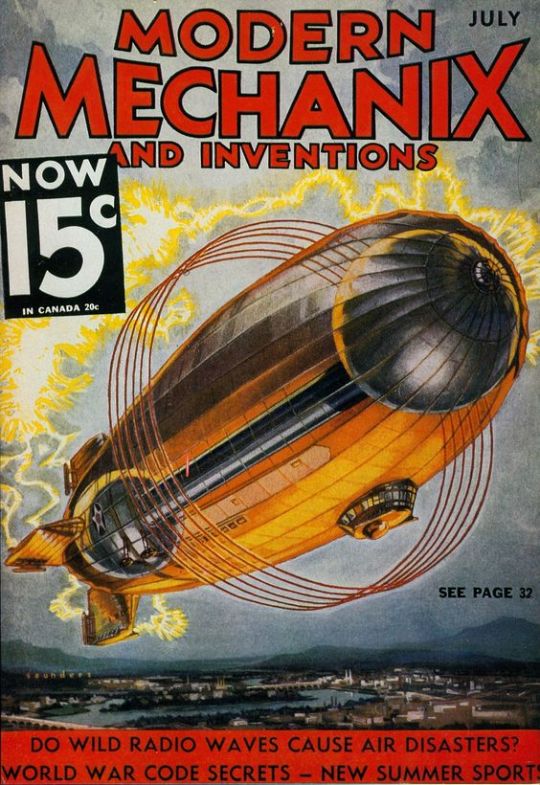


299 notes
·
View notes
Note
Do you have a collection of the vintage B&W photos of wacky sci-fi and home TV inventions that strap to your head, etc…? I’d love to get a few to frame and display in my Home Theater. Thanks!

I could do a whole post that's nothing but headgear worn by Hugo Gernsback. He created the first science fiction magazine, Amazing Stories, primarily as an advertisement for his radio parts company for electronic enthusiasts. This is why the line between science fiction fan and science/radio enthusiast was extremely blurry. Most early scifi fans of the First Fandom (anyone active in scifi prior to 1939) were also technical tinkerers.
More than that, Gernsback created the first letters page, where people wrote in their comments, and encouraged people to write to each other and become friends, which started off the first known generation of Fandom in the US, First Fandom. The first convention, Worldcon in 1939, started by the connections made in the letters pages of this magazine. In other words, "geek culture" as we know it today started off because this one man in 1928 wanted to sell radio parts to weirdos.

Here's one of his isolator device, which was designed to encourage productivity.
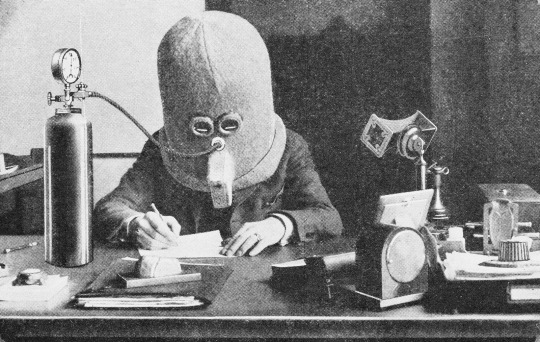
It's one of those very Silcon Valley ideas in that, in theory, it might increase productivity but completely misses the point of what it is to be a human being. People don't want to drink soylent protein drinks in lieu of eating good old ham and eggs in the morning (most people find Jetsons style nutrition in pill form to be hideous) and people certainly don't want to wear diving bells to get work done.

296 notes
·
View notes
Text
Autogiros over New York, 1930
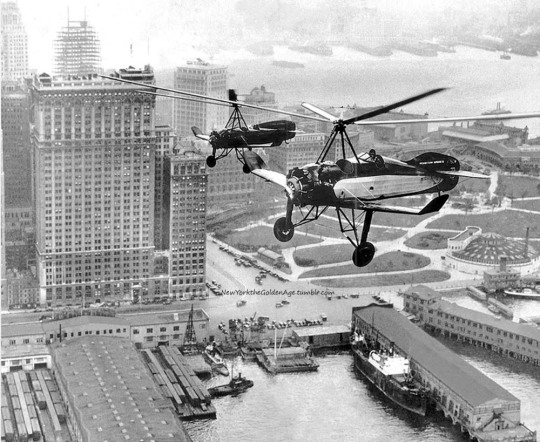
They're called autogiros, gyroplanes, gyrocopters, and rotaplanes. But when a NY Times reporter saw them for the first time, he described them as "airships resembling dragonflies" and "windmill planes." In this photo, the airships fly, flit and hover over the Battery.
"No stranger craft are ever seen in the sky," The Times wrote on November 16, 1930. "They are neither helicopters nor airplanes, but some of the merits of both. They can fly slow or fast, they can almost stop in the air, and they can rise from a small space and land in it."
Juan de la Cierva of Spain invented the autogiro in 1923. Seven years later, when this photo was taken, the whirlybirds were in the news often. Amelia Earhart took a passenger up in an autogiro in Willow Grove, Pa., and an autogiro flew across the English Channel. One inventor in 1930 predicted that most airplanes of the future "would be autogiros or something better," and would travel 200 miles per hour and carry seven tons.
Photo: NY Times Photo Archives
374 notes
·
View notes
Photo

1928 The Samuel Novarro House of Los Angeles, California, designed by Frank Lloyd Wright Jr. From Art Deco, FB.
618 notes
·
View notes
Text

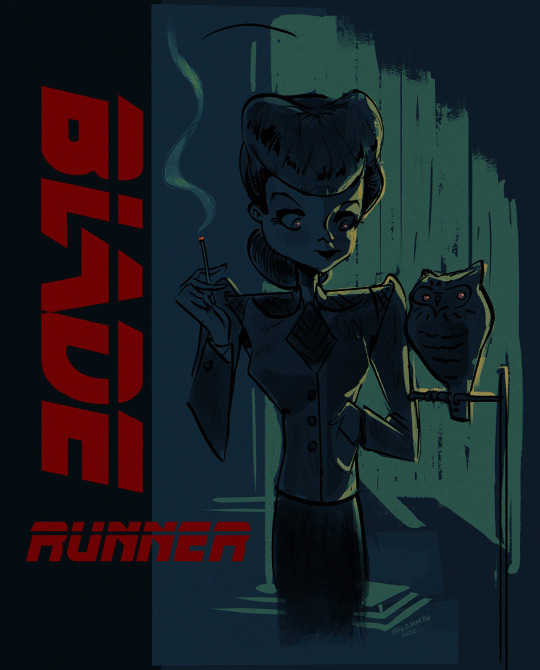




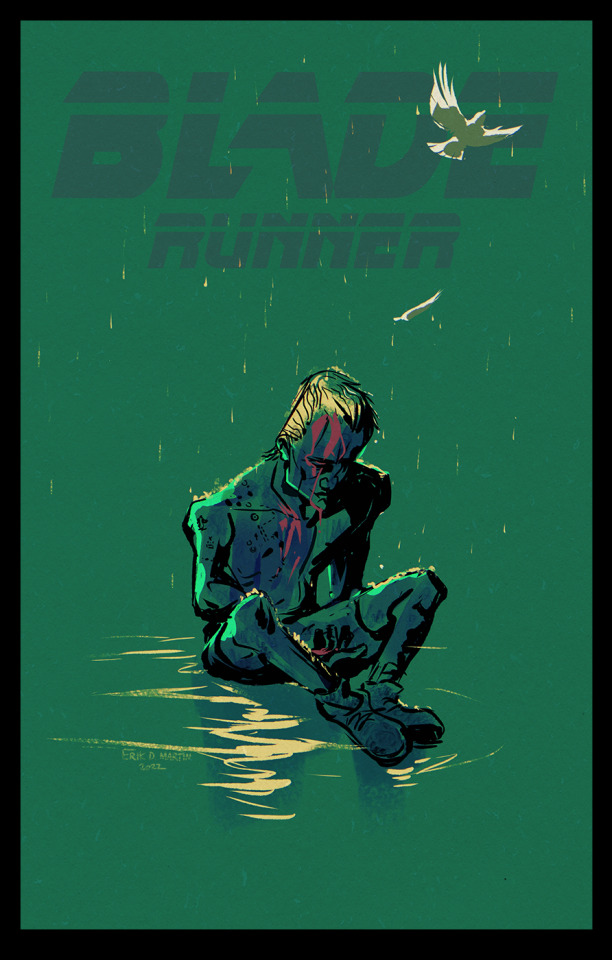
On this day Rachel had her Voight-Kampff Test done by Deckard! Felt appropriate to post a handful of illustrations I would do in my downtime while trying to imagine Blade Runner as an animated show.
427 notes
·
View notes
Photo
Blacksad, by Juanjo Guarnido


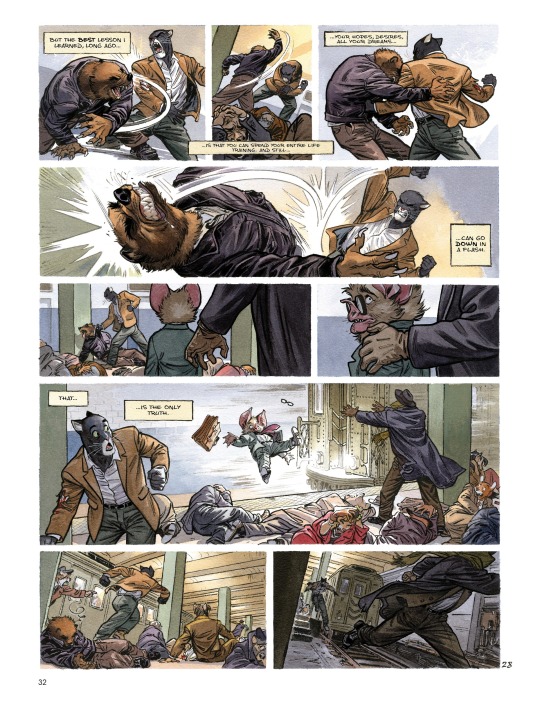

Blacksad: They All Fall Down Part 1
62 notes
·
View notes
Photo
The Spider -- guns akimbo!
March 1942.
Illustration by Rafael DeSoto

The Gentleman From Hell
https://pulpcovers.com/the-gentleman-from-hell/
71 notes
·
View notes